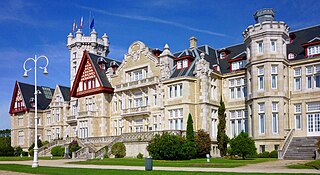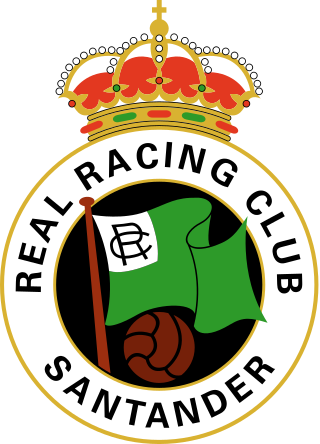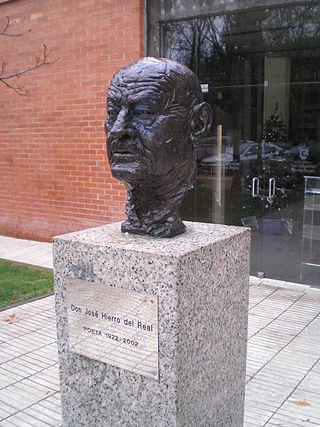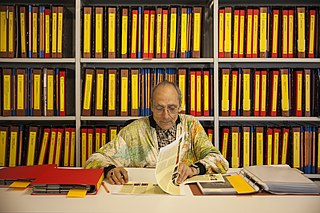
Santander is the capital of the autonomous community of Cantabria, Spain. It has a population of 172,000 (2017). It is a port city located in the northern coast of the Iberian Peninsula, facing the Cantabrian Sea.

Real Racing Club de Santander, S.A.D., also known as Racing de Santander or simply Racing, is a football club based in Santander, Cantabria, Spain, that currently competes in Segunda División, the second tier of the Spanish league system. It was founded in 1913. It holds home games at Campos de Sport de El Sardinero, with a capacity for 22,222 spectators. It is one of the ten founding clubs of La Liga.

Eduardo Arroyo Rodríguez was a Spanish painter and graphic artist. He was also active as an author and set designer. Arroyo is regarded as one of the most important exponents of politically committed realism.
Juan UsléOceja is a Spanish contemporary painter. His work varies between abstraction and figurative representation. In 2002, he received the Premio Nacional de Artes Plásticas, a national arts prize awarded by the Ministerio de Cultura of Spain. He works both in New York City and in Saro in Cantabria.

Rayo Cantabria, formerly known as Real Racing Club de Santander "B" is the reserve team of Racing de Santander, a Spanish football team based in Santander, in the autonomous community of Cantabria.
The King Alfonso XIII's Cup 1925 was the 25th staging of the Copa del Rey, the Spanish football cup competition.

The King Alfonso XIII's Cup 1928 was the 28th staging of the Copa del Rey, the Spanish football cup competition.

Albert Ràfols-Casamada was a Spanish painter, poet and art teacher involved in the vanguard movements of his time. He is considered one of the most important, multifaceted Catalan artists of his time. His artwork began in the post-expressionist, figurative sphere but soon developed into his own abstract style grounded in a poetic rendering of everyday reality.

José Hierro del Real, sometimes colloquially called Pepe Hierro, was a Spanish poet. He belonged to the so-called postwar generation, within the rootless and existential poetry streams. He wrote for both Espadaña and Garcilaso magazines. In 1981, he received the Prince of Asturias Awards in Literature, in 1998 the Cervantes Prize and he received many more awards and honours.

The Anjana are one of the best-known fairies of Cantabrian mythology. These female fairy creatures foil the cruel and ruthless Ojáncanu. In most stories, they are the good fairies of Cantabria, generous and protective of all people. Their depiction in the Cantabrian mythology is reminiscent of the lamias in ancient Greek mythology, as well as the xanas in Asturias, the janas in León, and the lamias in Basque Country, the latter without the zoomorphic appearance.
Eusebio Sempere Juan was a Spanish sculptor, painter, and graphic artist whose abstract geometric works make him the most representative artist of the Kinetic art movement in Spain and one of Spain's foremost artists. His use of repetition of line and mastery of color to manipulate the way light plays on the surface give depth to his pictorial compositions.

Antoni Miralda is a Spanish multidisciplinary artist.
The following is a timeline of the history of the city of Santander, Cantabria, Spain.
José Antonio Saro Palleiro is a Spanish retired footballer who played as a winger, and a current coach.
Miquel Navarro is a Spanish sculptor, painter and contemporary poet.

Luis Bezeta is a visual artist and Spanish filmmaker.
Elena Asins was a prominent visual artist, writer, lecturer and critic. Her plastic language was based on computer systematic calculation. Asins pioneered the convergence between theoretical computer science and the minimal and geometrical tendencies of the 1960s. She belongs to the first generation of artists using computers to generate art.

The Museo de Arte Moderno y Contemporáneo de Santander y Cantabria is an art museum in Santander, Spain. Today the museum specializes in modern and contemporary art.
Marco Camus Muñoz is a Spanish professional footballer who plays as a right winger for Valencia CF Mestalla.
Blood Orange Summer Glut is a sculpture made of junk metal by Robert Rauschenberg in 1987. Belonging to the Glut series, it is part of the Institut Valencià d'Art Modern collection. It is widely recognized as one of the best pieces in this museum's collection, being exhibited in exhibitions at centers such as MAXXI in Rome, or MACA in Alicante.










